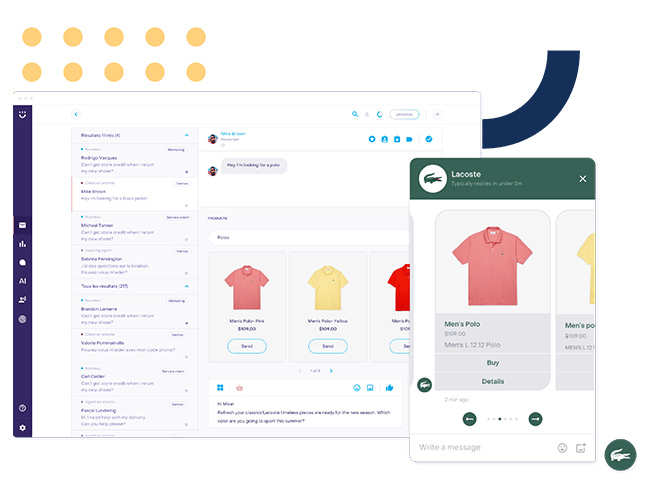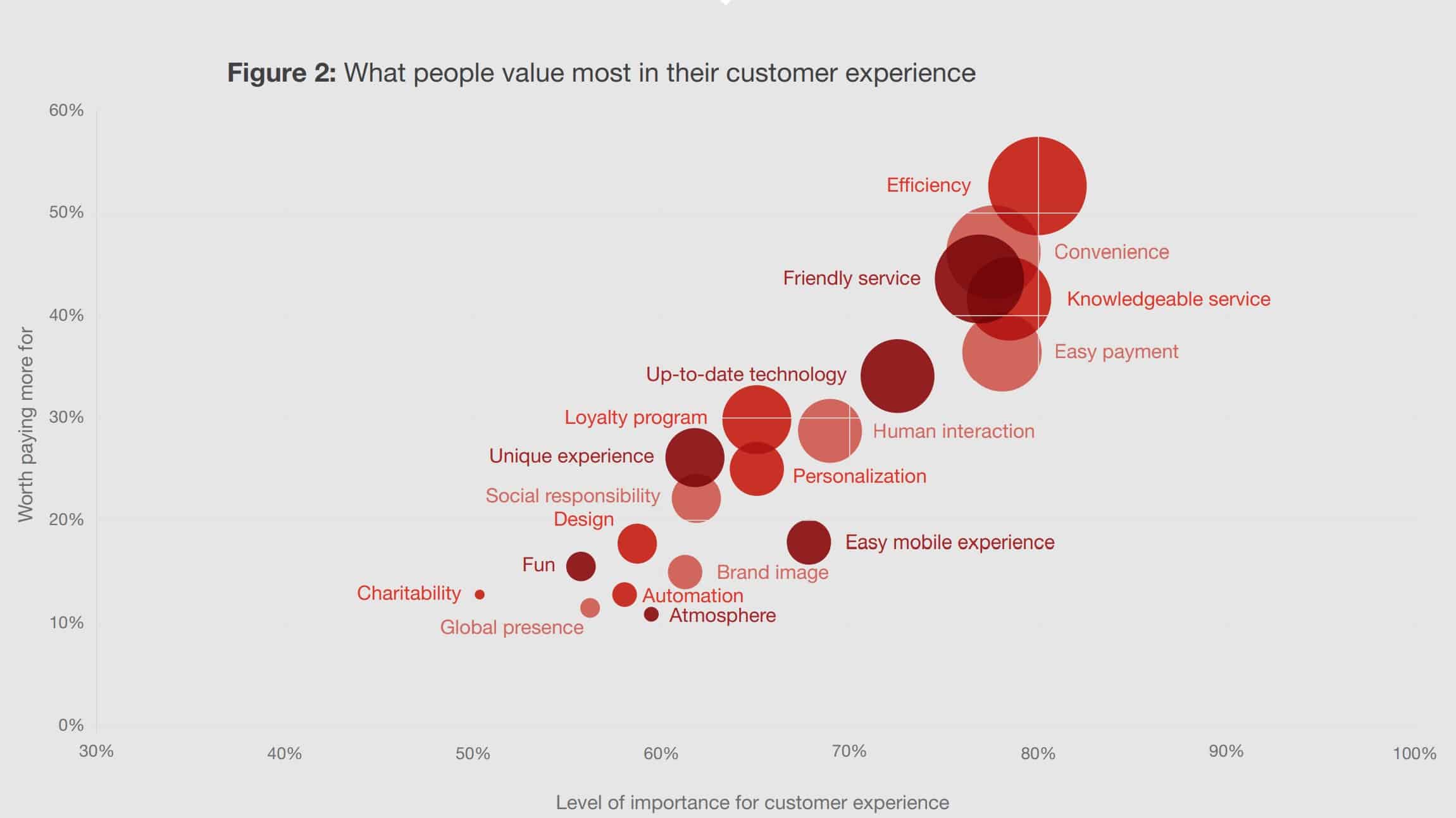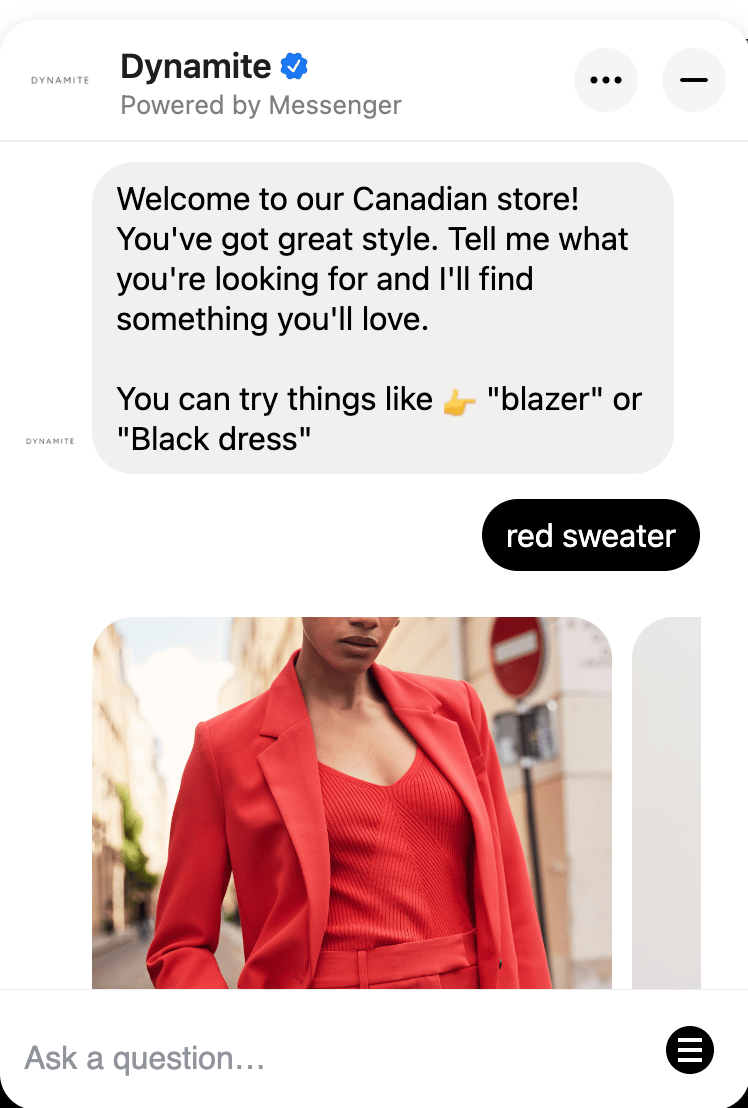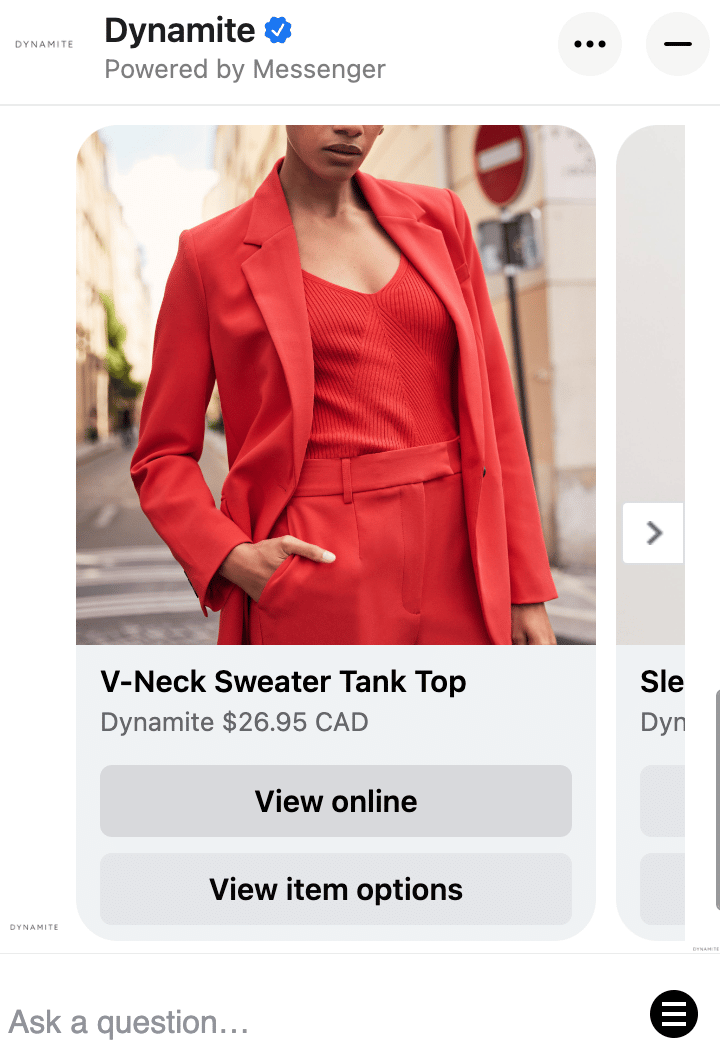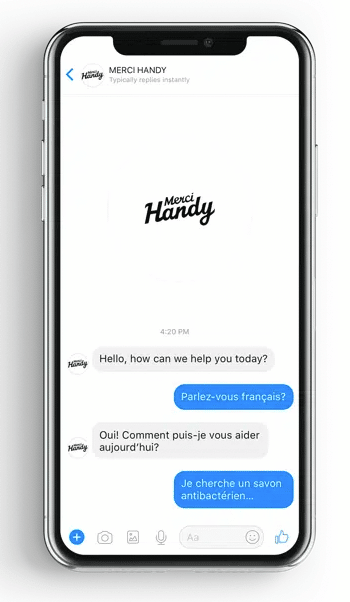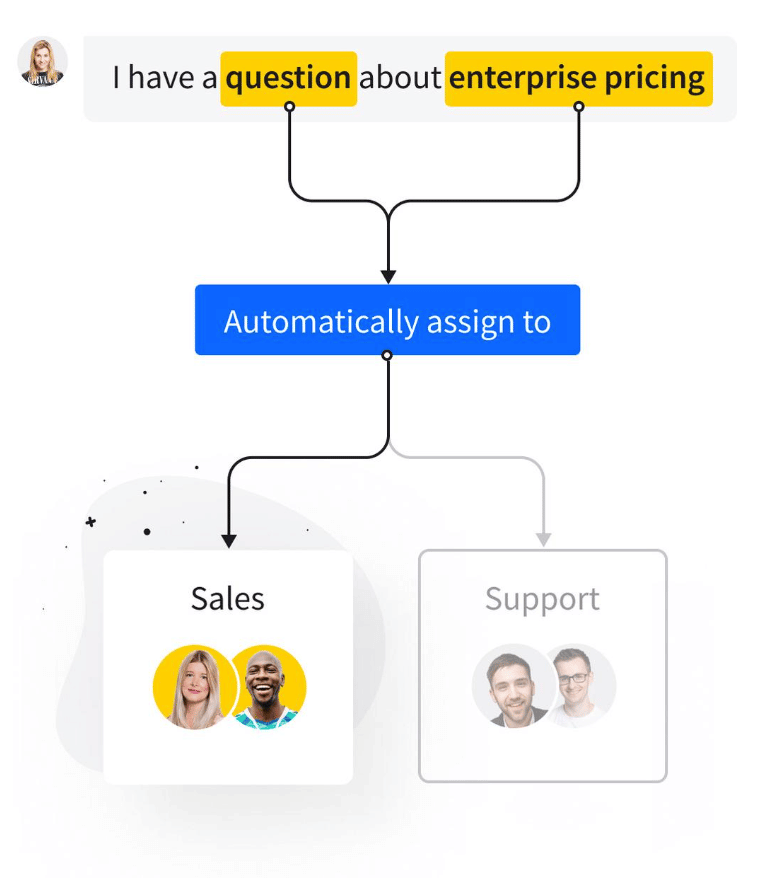What is Conversational Commerce and Why Does it Matter for Brands?
Imagine walking into a store only to find there’s nobody to greet you. You walk through the store and can’t find anything. You have questions about products you’re interested in. But no one is there to answer. You leave empty-handed.
Without conversational commerce, this happens online all the time. More customers are shopping online than offline. That’s no excuse for skipping out on quality customer service.
Learn how to take your customer service digital with conversational commerce.
Bonus: Learn how to sell more products on social media with our free Social Commerce 101 guide. Delight your customers and improve conversion rates.
What is conversational commerce?
Conversational commerce (or social commerce, or conversational marketing) uses conversation to better serve customers. Conversational commerce takes your customer service digital. It makes it possible to talk to thousands of potential customers at once.
These conversations happen anywhere customers are: social media, messenger apps, and your website. Conversations happen with live customer service agents, chatbots, or both.
Why is conversational commerce important?
Conversational commerce makes shopping online easier, more fun, and more personal for customers.
The Future of Customer Experience Survey by PwC shows customers are looking for speed, convenience, and friendliness when shopping. The survey also found:
- 73% of customers consider experience an important part of their buying decision. But, only 49% of customers say companies provide good customer service.
- 1 in 3 customers (32%) will leave a brand forever with one bad customer service experience.
- 65% of customers say a positive experience is more influential than great advertising.
Businesses who use conversational commerce see:
- A 10% increase in revenue in the first 6 months
- An average of 30% in savings of savings on customer service costs.
- Automation of up to 80% of the most common customer interactions. AI chatbots can increase efficiency and accuracy in conversations with customers.
Source: PwC Future of Customer Service Experience Survey
Types of conversational commerce
You don’t need to be the fastest talker in the west to join the conversation. Many brands are using these tools to talk to more customers online:
Conversational AI chatbots
An AI chatbot is a robot customer service agent. Yes. We are living in the future.
Through automation, a chatbot allows customers to connect with a brand instantly.
When people think of personalized service, a friendly robot may not come to mind. But, chatbots like Heyday, use machine learning to give personal responses to customers. These responses become more accurate and effective over time. Like a real agent, an AI conversational chatbot remembers its customers.
Chatbots like Heyday can also answer all the FAQs coming in, saving your team valuable time and resources.
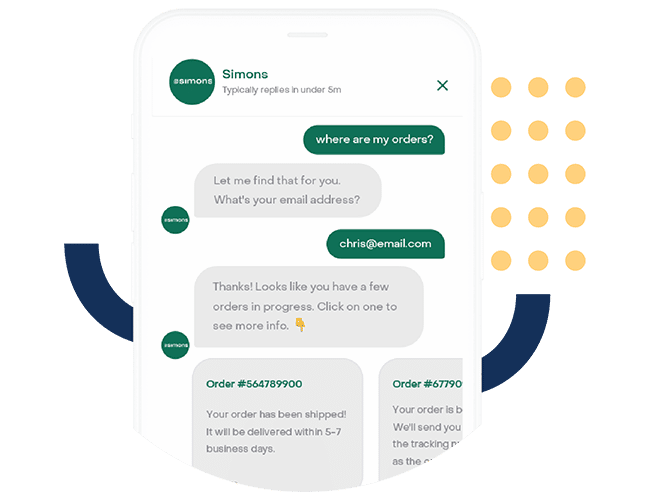
Source: Heyday
Live chat apps
A live chat app gives customers the option to message a real-live customer service agent. Long gone are the days of the dreaded customer service form and 1-800 numbers.
Live chat apps allows automation of common answers to common questions. Human customer service can focus on the people who need extra help the most.
64% of customers would prefer to use a chat app than call customer service.
Live chat allows customer service to respond to many customers at once. Which creates more efficiency and a better customer experience.
Voice assistant software
Conversational commerce also includes using voice assistants to answer questions. More people are asking Siri, Alexa, or Google Assistant questions to make their purchases.
One survey of online millennial shoppers found almost half (47%) used a voice assistant to make a purchase.
Marketers should think of common questions or orders from customers. It’s much easier for a customer to ask Alexa to order something, than to click through your product pages.
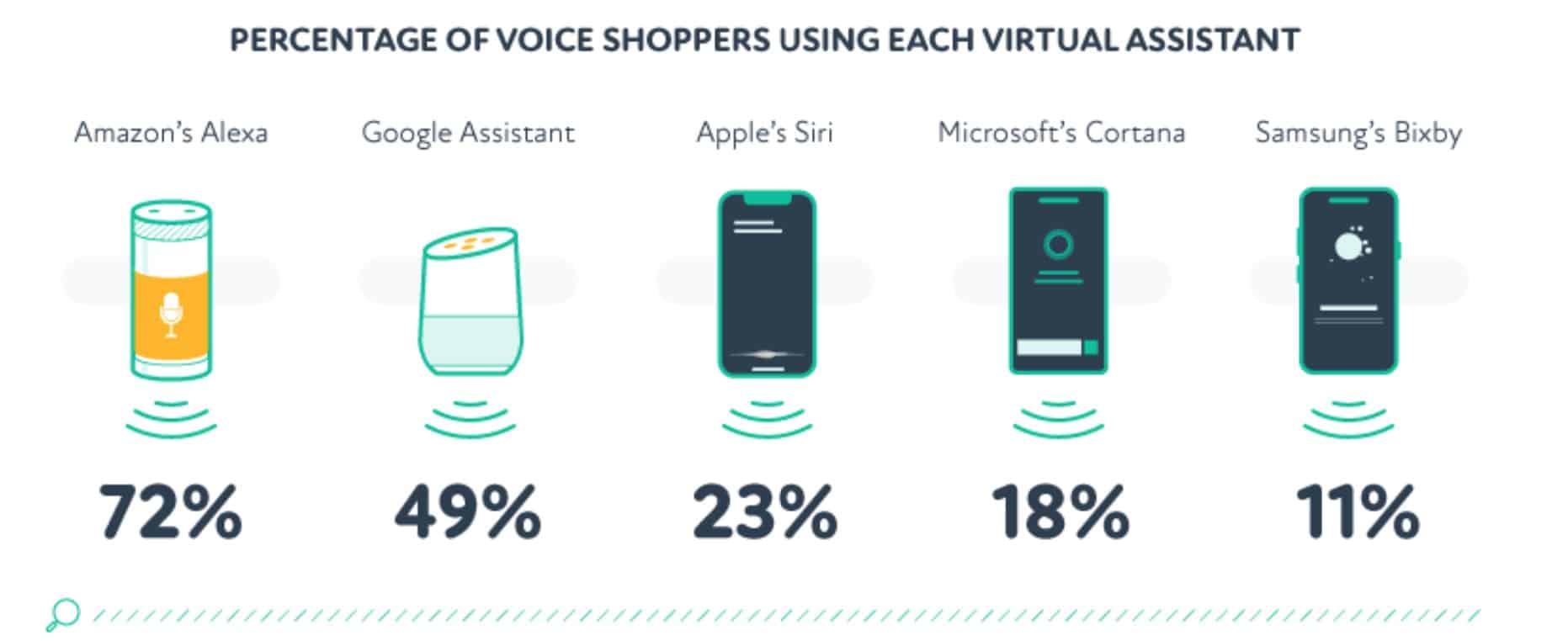
Source: Survey of 1038 online shoppers
Messaging apps
People use social messaging apps more than social media. The user base of the top four messaging apps is larger than the user base of the top four social media platforms.
Customers are deciding what to buy before visiting a company’s website. People use social messaging apps more like search engines. More questions are coming through a company’s Facebook Messenger or WhatsApp. Make sure someone, or something, is there to answer them!
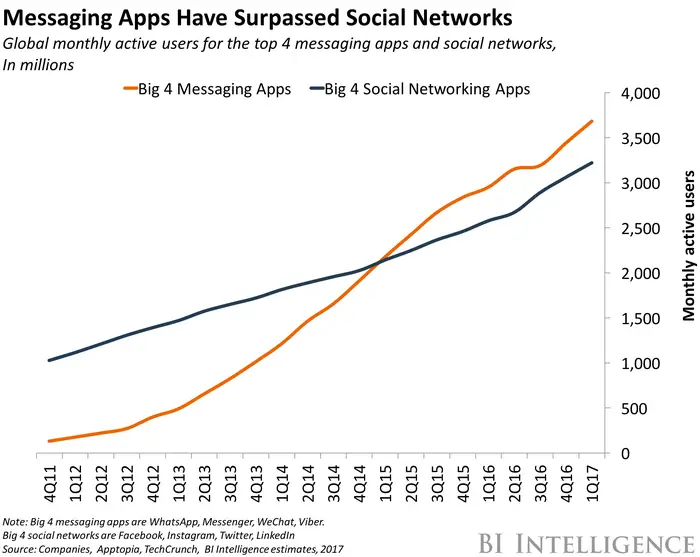
Source: The Messaging Apps Report, Business Insider
Social media
A new study from Publicis and Twitter, says “social conversations are the new online review.”
- 92% of people seek out information on a brand on social media.
- 64% of people will change their minds about a brand after reading about them on social media.
The discussions happening around your brand are driving sales. It’s time to embrace those conversations and encourage customers to post photos and reviews on social media.
Read our guide for building a strong customer service experience on socials. And also learn more about social selling.
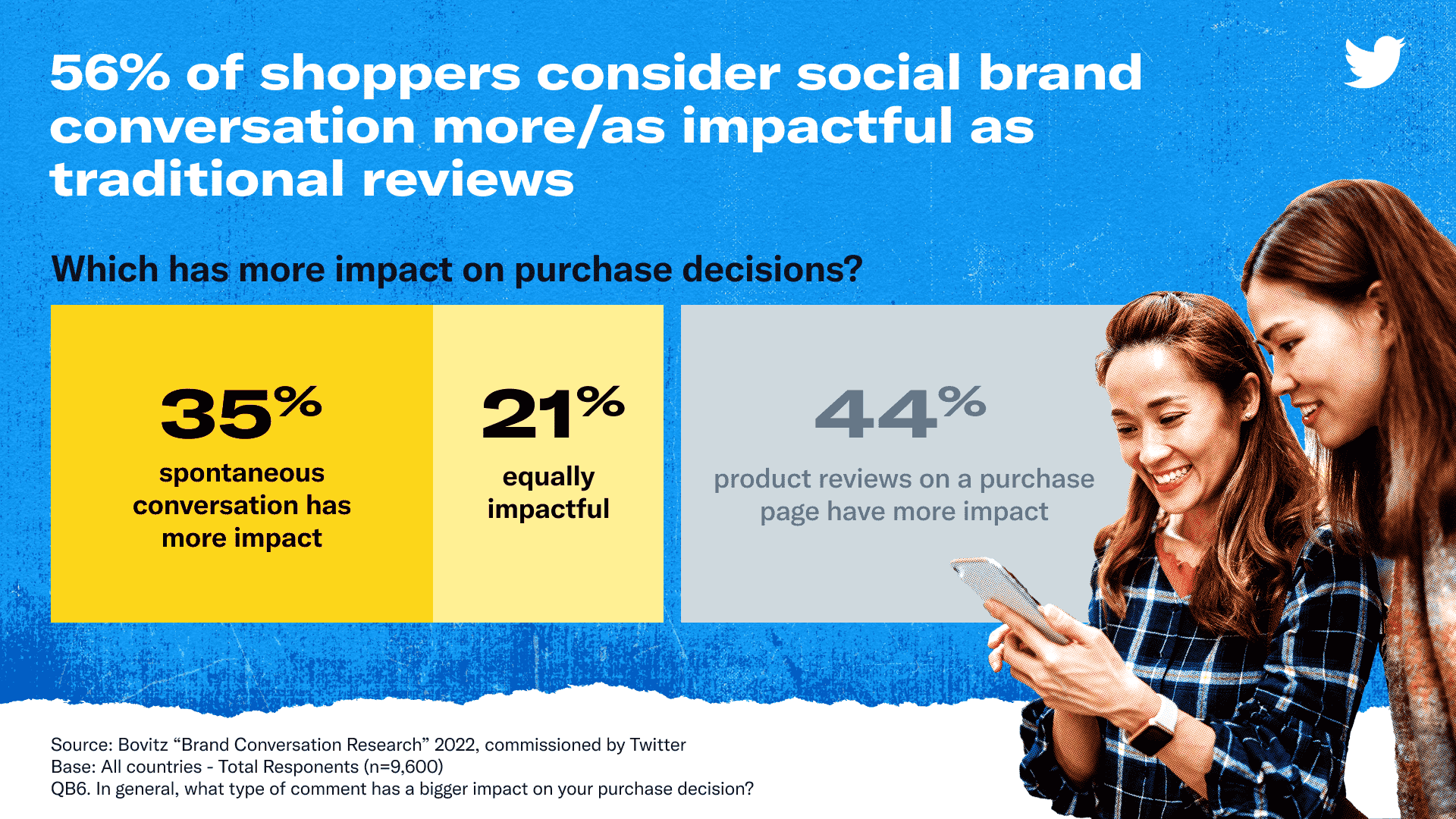
Source: Twitter
Bonus: Learn how to sell more products on social media with our free Social Commerce 101 guide. Delight your customers and improve conversion rates.
Get the guide now!6 benefits of using conversational commerce
When shopping, customers seek speed, friendliness, and helpfulness as the top qualities.
Here are our top six ways conversational commerce delivers this experience.
1. Give 24/7 customer support
It’s called instant messaging for a reason. Customers want answers to their questions right away. Offering a high level of 24/7 customer support is impossible without it.
Through chatbots, businesses can respond to customers faster. Chatbots can also answer common questions right away. Or, give customers the option to schedule a call with a live agent when they are available.
2. Drive sales through chats and relationships
Customers reaching out via messenger or chat provide valuable information. Chatbots or live agents can suggest products based on the customer’s needs.
For example, the Canadian brand Dynamite uses a Heyday chatbot on their website. If a customer is looking for a red sweater, the chatbot serves up different products for the customer.They can even buy within the chat!
Source: Dynamite
Adding a personal touch sells more products. Through chatbots, brands can learn more about their customers.
By assigning agents to repeat customers, brands can build relationships online. Like in stores, customers are far more likely to buy and return when the brand seems eager to help.
3. Reduce abandoned shopping carts
Abandoned shopping carts are a huge issue in ecommerce. The ecommerce industry loses $18 billion a year from abandoned shopping cart orders.
A conversational commerce tool can help reduce that number by:
- Sending customers who abandon shopping carts reminders or nudges to complete their order.
- Checking-in to see what has stopped customers from buying and gain valuable info to close the deal.
- Sending customers looking for certain products, like a tennis racket, an automated link directly to the product.
4. Collect customer data and feedback
Your relationship with a customer doesn’t have to end once they buy a product. Your chatbot can follow up with the customer to receive reviews or feedback, saving live agents valuable time.
You can also send automated follow-ups to customers to increase the chance of a review. 63% of customers are more willing to offer more personal information if they have a great experience.
5. Generate more and better quality leads
Conversational commerce opens up a new world of meeting new customers.
With the help of a chatbot you can
- Send your top customers a message to ask for a customer review or referral.
- Automate sales call bookings through chat to get more appointments and less no-shows.
- Send a message to upsell an extra product of interest.
55% of businesses that use conversational commerce receive better quality leads as well.
6. More languages
Customers now have the ability to shop all around the world. Many companies miss out on the opportunity to engage customers who don’t speak the same language.
A multilingual chatbot breaks down language barriers. Answer FAQs in other languages without hiring a whole new team.
You can use AI to answer questions and perform simple tasks in a customer’s preferred language. For example, Merci Handy serves customers in both French and English using Heyday’s chatbot. No live agent or translator necessary.
Source: Heyday
Best practices for using conversational commerce
Conversational commerce plays a different role depending on where your customer is at. Find balance between being helpful and not annoying.
Be the digital version of a helpful customer service agent. Not the digital version of a used car salesperson.
These best practices will help you get the most out of conversational commerce.
Awareness
Awareness-focused conversation happens on messengers and social media. This is before customers even visit your website. The goal here is to be quick to respond, helpful, and relevant.
Do:
- Set up automations for FAQs to provide immediate responses to customers.
- Have a welcome message go out to people visiting your website to engage them.
- Make it easy and clear that customer service is open and available through chat 24/7.
Don’t:
- Spam customers.
- Wait too long before answering customers. Most customers expect an immediate response.
Consideration/Decision
As customers make their final selections, ensure there is a live chat option on your website. Close that deal!
Do:
- Provide short and to-the-point answers for customers.
- Connect customers with specific questions or concerns to a live agent.
- Include an obvious “live chat” button. Make it easy for customers to connect, especially on product and contact pages.
Don’t:
- Put pressure on customers to close deals.
- Be afraid to follow up. Research shows interest decays overtime.
Retention
When a person visits your website, you want to try to make the visitor become a customer, or if they buy a product, then a repeat customer. You can strive to do that in a few ways.
Do:
- Create a welcome pop-up.
- Link customers to review pages or surveys and ask for feedback.
- Welcome a known customer back to your website with special offers or promotions.
- Send a thank-you when customers complete an order.
Don’t:
- Follow-up aggressively and try to make a new sale.
According to research from Twitter, 71% of people feel much more likely to consider buying if they talk with a brand before shopping.
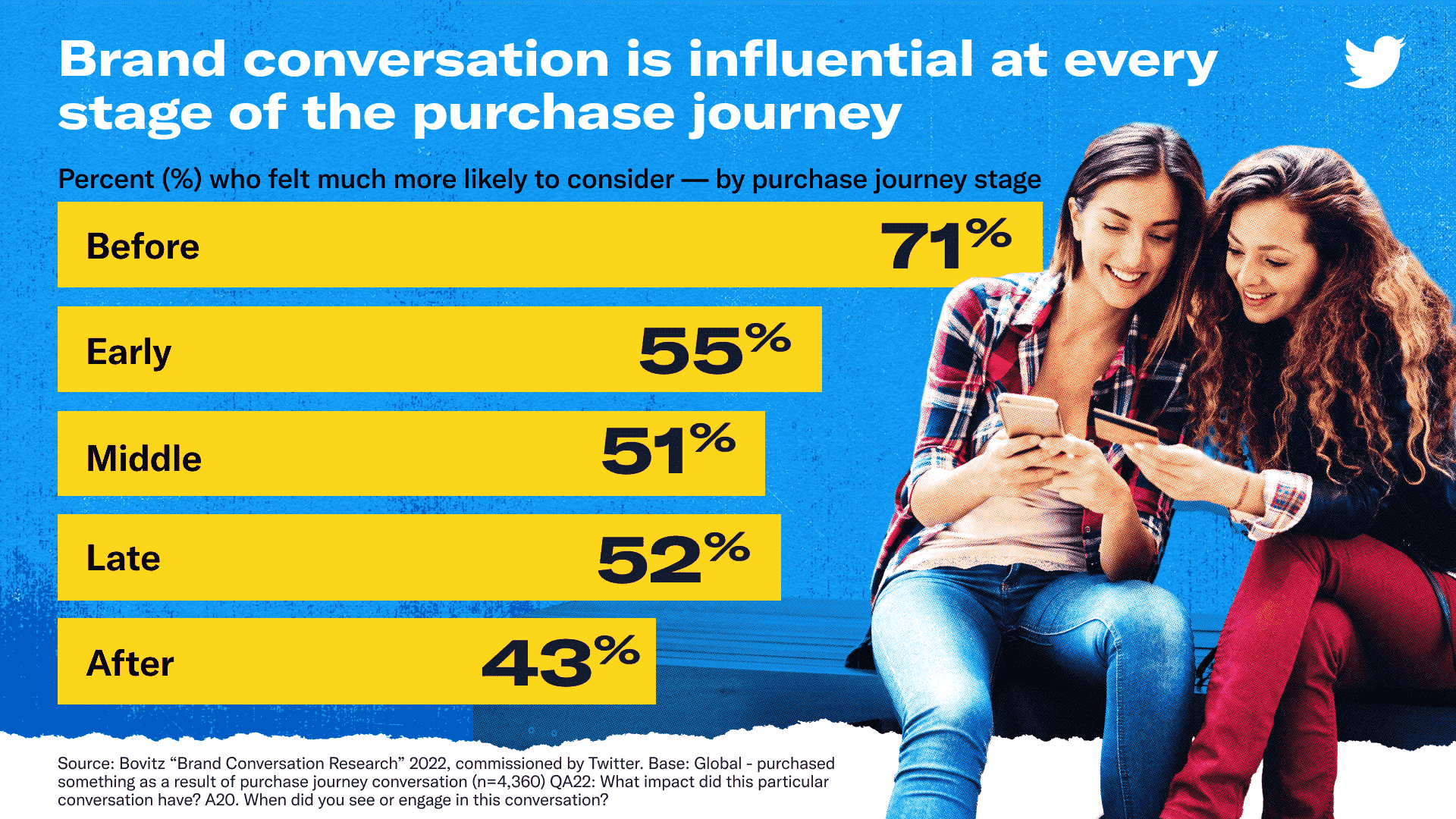 Source: Twitter
Source: Twitter
Top conversational commerce platforms
Heyday
Heyday by Hootsuite is a conversational commerce platform. Heyday uses machine learning to automate up to 80% of the most common customer interactions.
Heyday also manages live customer service on the same platform. It’s a smart chatbot that can manage FAQs, is multilingual and will connect the customer to a live agent when necessary.
Heyday integrates with the top ecommerce platforms like Shopify. You can be set up in as little as 10-minutes!
Facebook Messenger
As far as free tools go, Facebook Messenger has recently added a lot of new chatbot tools for businesses to use. Messenger is the most common chat app in North America. The number of messages sent to businesses on Facebook has doubled in the past year.
Facebook Messenger is the first place customers look to learn more. Facebook messenger has automations for businesses to respond to common questions. It also helps organize messages from Facebook and Instagram channels into one dashboard.
Note that Facebook Messenger doesn’t integrate with other platforms or your website.
To help manage the conversations within Facebook Messenger, try Hootsuite. Hootsuite is a social media marketing and management tool. It allows you to easily manage all incoming messages across platforms.
LiveChat
LiveChat is an all-in-one live chat platform for your customer service team. The platform organizes all your customer interactions with live agents.
LiveChat will automatically segment visitors to your website based on what they do on your site, so you can better meet customer needs. It can also anticipate questions as customers are typing to help your team respond faster.
Source: LiveChat
Drift
Drift is another option for a live chat platform. It connects real sales reps with customers on your website and is quickly becoming a popular choice.
It has a few automated chat features. People can connect with live agents right away, or book appointments. Drift has beautiful dashboards and many live chat features. It can be a great tool to build simple chatbots.
Engati
Engati is a rising star in the chat bot world. It’s a simple option for those getting started in conversational commerce. Engati’s main selling feature is its intuitive chatbot builder. It allows you to automate simple chats on your website and messaging apps like What’s App.
Start automating your customer service. Provide a simple easy-to-use platform for your customer service team with Heyday.
Turn customer service conversations into sales with Heyday. Improve response times and sell more products. See it in action.
Free DemoThe post What is Conversational Commerce and Why Does it Matter for Brands? appeared first on Social Media Marketing & Management Dashboard.
Categories
- 60% of the time… (1)
- A/B Testing (2)
- Ad placements (3)
- adops (4)
- adops vs sales (5)
- AdParlor 101 (43)
- adx (1)
- algorithm (1)
- Analysis (9)
- Apple (1)
- Audience (1)
- Augmented Reality (1)
- authenticity (1)
- Automation (1)
- Back to School (1)
- best practices (2)
- brand voice (1)
- branding (1)
- Build a Blog Community (12)
- Case Study (3)
- celebrate women (1)
- certification (1)
- Collections (1)
- Community (1)
- Conference News (1)
- conferences (1)
- content (1)
- content curation (1)
- content marketing (1)
- contests (1)
- Conversion Lift Test (1)
- Conversion testing (1)
- cost control (2)
- Creative (6)
- crisis (1)
- Curation (1)
- Custom Audience Targeting (4)
- Digital Advertising (2)
- Digital Marketing (6)
- DPA (1)
- Dynamic Ad Creative (1)
- dynamic product ads (1)
- E-Commerce (1)
- eCommerce (2)
- Ecosystem (1)
- email marketing (3)
- employee advocacy program (1)
- employee advocates (1)
- engineers (1)
- event marketing (1)
- event marketing strategy (1)
- events (1)
- Experiments (21)
- F8 (2)
- Facebook (64)
- Facebook Ad Split Testing (1)
- facebook ads (18)
- Facebook Ads How To (1)
- Facebook Advertising (30)
- Facebook Audience Network (1)
- Facebook Creative Platform Partners (1)
- facebook marketing (1)
- Facebook Marketing Partners (2)
- Facebook Optimizations (1)
- Facebook Posts (1)
- facebook stories (1)
- Facebook Updates (2)
- Facebook Video Ads (1)
- Facebook Watch (1)
- fbf (11)
- first impression takeover (5)
- fito (5)
- Fluent (1)
- Get Started With Wix Blog (1)
- Google (9)
- Google Ad Products (5)
- Google Analytics (1)
- Guest Post (1)
- Guides (32)
- Halloween (1)
- holiday marketing (1)
- Holiday Season Advertising (7)
- Holiday Shopping Season (4)
- Holiday Video Ads (1)
- holidays (4)
- Hootsuite How-To (3)
- Hootsuite Life (1)
- how to (5)
- How to get Instagram followers (1)
- How to get more Instagram followers (1)
- i don't understand a single thing he is or has been saying (1)
- if you need any proof that we're all just making it up (2)
- Incrementality (1)
- influencer marketing (1)
- Infographic (1)
- Instagram (39)
- Instagram Ads (11)
- Instagram advertising (8)
- Instagram best practices (1)
- Instagram followers (1)
- Instagram Partner (1)
- Instagram Stories (2)
- Instagram tips (1)
- Instagram Video Ads (2)
- invite (1)
- Landing Page (1)
- link shorteners (1)
- LinkedIn (22)
- LinkedIn Ads (2)
- LinkedIn Advertising (2)
- LinkedIn Stats (1)
- LinkedIn Targeting (5)
- Linkedin Usage (1)
- List (1)
- listening (2)
- Lists (3)
- Livestreaming (1)
- look no further than the new yorker store (2)
- lunch (1)
- Mac (1)
- macOS (1)
- Marketing to Millennials (2)
- mental health (1)
- metaverse (1)
- Mobile App Marketing (3)
- Monetizing Pinterest (2)
- Monetizing Social Media (2)
- Monthly Updates (10)
- Mothers Day (1)
- movies for social media managers (1)
- new releases (11)
- News (72)
- News & Events (13)
- no one knows what they're doing (2)
- OnlineShopping (2)
- or ari paparo (1)
- owly shortener (1)
- Paid Media (2)
- People-Based Marketing (3)
- performance marketing (5)
- Pinterest (34)
- Pinterest Ads (11)
- Pinterest Advertising (8)
- Pinterest how to (1)
- Pinterest Tag helper (5)
- Pinterest Targeting (6)
- platform health (1)
- Platform Updates (8)
- Press Release (2)
- product catalog (1)
- Productivity (10)
- Programmatic (3)
- quick work (1)
- Reddit (3)
- Reporting (1)
- Resources (34)
- ROI (1)
- rules (1)
- Seamless shopping (1)
- share of voice (1)
- Shoppable ads (4)
- Skills (28)
- SMB (1)
- SnapChat (28)
- SnapChat Ads (8)
- SnapChat Advertising (5)
- Social (169)
- social ads (1)
- Social Advertising (14)
- social customer service (1)
- Social Fresh Tips (1)
- Social Media (5)
- social media automation (1)
- social media content calendar (1)
- social media for events (1)
- social media management (2)
- Social Media Marketing (49)
- social media monitoring (1)
- Social Media News (4)
- social media statistics (1)
- social media tracking in google analytics (1)
- social media tutorial (2)
- Social Toolkit Podcast (1)
- Social Video (5)
- stories (1)
- Strategy (608)
- terms (1)
- Testing (2)
- there are times ive found myself talking to ari and even though none of the words he is using are new to me (1)
- they've done studies (1)
- this is also true of anytime i have to talk to developers (1)
- tiktok (8)
- tools (1)
- Topics & Trends (3)
- Trend (12)
- Twitter (15)
- Twitter Ads (5)
- Twitter Advertising (4)
- Uncategorised (9)
- Uncategorized (13)
- url shortener (1)
- url shorteners (1)
- vendor (2)
- video (10)
- Video Ads (7)
- Video Advertising (8)
- virtual conference (1)
- we're all just throwing mountains of shit at the wall and hoping the parts that stick don't smell too bad (2)
- web3 (1)
- where you can buy a baby onesie of a dog asking god for his testicles on it (2)
- yes i understand VAST and VPAID (1)
- yes that's the extent of the things i understand (1)
- YouTube (13)
- YouTube Ads (4)
- YouTube Advertising (9)
- YouTube Video Advertising (5)

